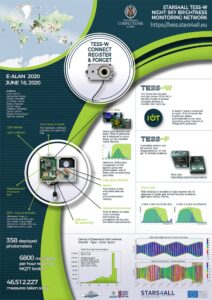Photometers TESS-W
Designed to measure and continuous monitoring the night sky brightness for ligth pollution studies

TESS-W was created during the STARS4ALL H2020 European Project with an open design (hardware and software). Our network of TESS-W photometers, in addition to TESS-P and TAS, are installed on all continents and to date, more than 1300 units have been purchased.
Once your photometer is calibrated and configured will start to send the measurements to the STARS4ALL infrastructure. These measurements can be visualized from our platform (http://tess.stars4all.eu/plots/). Plus, all data generated in the network can be downloaded from our Zenodo community (https://zenodo.org/communities/stars4all)

Professor Jaime Zamorano
Professional astronomer and Astrophysics professor at Universidad Complutense de Madrid (UCM).
Photometers Network
The Stars4all Foundation continues to maintain and develop a program to improve the data infrastructure of the STARS4ALL project, with special attention to data management and data opening processes related to photometer measurements. Each month, data is uploaded to the Zenodo community for free use by researchers.
With more than 250 photometers installed on all continents, and with the support of Institutions, Universities, and Governments that trust our instruments, the Stars4all photometer network is one of the most powerful, not only thanks to their quality, but for being open access and supported by expert scientists in the area of light pollution.
Result
In the following projects, the photometers developed in the STARS4ALL project are used:
- EELabs project led by the Institute of Astrophysics of the Canary Islands, is an INTERREG V-A MAC 2014-2020 project, co-financed by the ERDF (European Regional Development Fund) of the European Union, under contract number MAC2/4.6d /238.
- Mont-Megantic International Dark Sky Reserve. Led by Rémi Boucher, a DarkSky Advocate in Canada.
- Northumberland International Dark Sky Park – Monitoring Light Pollution Project, with the purpose of monitoring and reporting on changes in the quality of dark skies at Northumberland International Dark Sky Park. Led Officer: Duncan Wise.
- IluminAconCiencia project, implemented by the University of La Serena, Coquimbo Region, Chile. Led by Marcelo Jaque.
- Project for the monitoring of light pollution in the SÉPAQ network of national park in the province of Québec.
The following scientific articles have used the open data generated by the photometers of the Stars4all project:
- Bará, Tapia, Zamorano. Absolute Radiometric Calibration of TESS-W and SQM Night Sky Brightness Sensors. Physical Sensors 2019, 19(6), 1336
- Robles, Zamorano, Pascual, Sánchez de Miguel, Gallego & Gaston (2021). Evolution of Brightness and Color of the Night Sky in Madrid . Remote Sensing 2021, 13(8), 1511
- Albert D. Grauer & Patricia A. Grauer (2021). Linking solar minimum, space weather, and night sky brightness. Scientific Reports volume 11, Article number: 23893 (2021)
- Miguel R. Alarcón, Miquel Serra-Ricart, Samuel Lemes-Perera and Manuel Mallorquín. Natural night sky brightness during solar minimun. The astronomical Journal, Volume 162, Number 1 (2021)
- Fernádez-Ruiz, B., Serra-Ricart, M., Alarcón, M. R., Lemes-Perera, S., Santana-Pérez, I., & Ruiz-Alzola, J. (2023) Calibrating nighttime satellite imagery with red photometer networks. Remote Sensing, 15(17), 4189.
- Jaime Zamorano, Salvador Bará, Manuel Barco, Cristóbal García, Antonio Luis Caballero. Controlling the artificial radiance of the night sky: The Añora urban laboratory. Journal of Quantitative Spectroscopy & Radiative Transfer Volume 296, February 2023, 108454.
eALAN 2020, online 16 Jun (2020)


